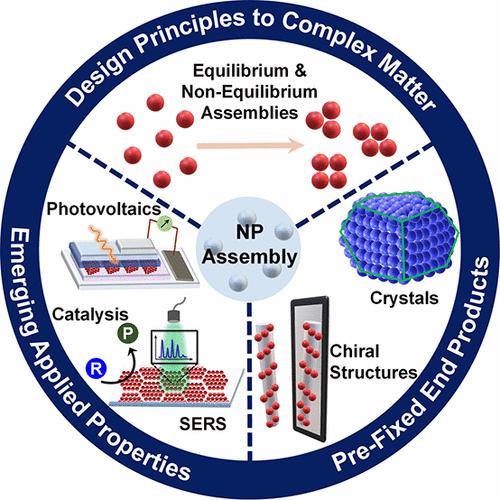当前位置:
X-MOL 学术
›
ACS Appl. Mater. Interfaces
›
论文详情
Our official English website, www.x-mol.net, welcomes your
feedback! (Note: you will need to create a separate account there.)
Nanoparticle Self-Assembly: From Design Principles to Complex Matter to Functional Materials
ACS Applied Materials & Interfaces ( IF 8.3 ) Pub Date : 2022-06-17 , DOI: 10.1021/acsami.2c05378
Anish Rao 1 , Sumit Roy 1 , Vanshika Jain 1 , Pramod P Pillai 1
ACS Applied Materials & Interfaces ( IF 8.3 ) Pub Date : 2022-06-17 , DOI: 10.1021/acsami.2c05378
Anish Rao 1 , Sumit Roy 1 , Vanshika Jain 1 , Pramod P Pillai 1
Affiliation

|
The creation of matter with varying degrees of complexities and desired functions is one of the ultimate targets of self-assembly. The ability to regulate the complex interactions between the individual components is essential in achieving this target. In this direction, the initial success of controlling the pathways and final thermodynamic states of a self-assembly process is promising. Despite the progress made in the field, there has been a growing interest in pushing the limits of self-assembly processes. The main inception of this interest is that the intended self-assembled state, with varying complexities, may not be “at equilibrium (or at global minimum)”, rendering free energy minimization unsuitable to form the desired product. Thus, we believe that a thorough understanding of the design principles as well as the ability to predict the outcome of a self-assembly process is essential to form a collection of the next generation of complex matter. The present review highlights the potent role of finely tuned interparticle interactions in nanomaterials to achieve the preferred self-assembled structures with the desired properties. We believe that bringing the design and prediction to nanoparticle self-assembly processes will have a similar effect as retrosynthesis had on the logic of chemical synthesis. Along with the guiding principles, the review gives a summary of the different types of products created from nanoparticle assemblies and the functional properties emerging from them. Finally, we highlight the reasonable expectations from the field and the challenges lying ahead in the creation of complex and evolvable matter.
中文翻译:

纳米粒子自组装:从设计原理到复杂物质再到功能材料
创造具有不同复杂程度和所需功能的物质是自组装的最终目标之一。调节各个组件之间复杂相互作用的能力对于实现此目标至关重要。在这个方向上,控制自组装过程的路径和最终热力学状态的初步成功是有希望的。尽管该领域取得了进展,但人们对突破自组装过程的限制越来越感兴趣。这种兴趣的主要起源是预期的自组装状态,具有不同的复杂性,可能不是“处于平衡状态(或处于全局最小值)”,使得自由能最小化不适合形成所需的产品。因此,我们认为,透彻理解设计原则以及预测自组装过程结果的能力对于形成下一代复杂物质的集合至关重要。本综述强调了微调纳米材料中粒子间相互作用的强大作用,以实现具有所需特性的首选自组装结构。我们相信,将设计和预测引入纳米粒子自组装过程将产生类似于逆合成对化学合成逻辑的影响。除了指导原则外,该综述还总结了由纳米粒子组装而成的不同类型的产品以及它们所产生的功能特性。最后,
更新日期:2022-06-17
中文翻译:

纳米粒子自组装:从设计原理到复杂物质再到功能材料
创造具有不同复杂程度和所需功能的物质是自组装的最终目标之一。调节各个组件之间复杂相互作用的能力对于实现此目标至关重要。在这个方向上,控制自组装过程的路径和最终热力学状态的初步成功是有希望的。尽管该领域取得了进展,但人们对突破自组装过程的限制越来越感兴趣。这种兴趣的主要起源是预期的自组装状态,具有不同的复杂性,可能不是“处于平衡状态(或处于全局最小值)”,使得自由能最小化不适合形成所需的产品。因此,我们认为,透彻理解设计原则以及预测自组装过程结果的能力对于形成下一代复杂物质的集合至关重要。本综述强调了微调纳米材料中粒子间相互作用的强大作用,以实现具有所需特性的首选自组装结构。我们相信,将设计和预测引入纳米粒子自组装过程将产生类似于逆合成对化学合成逻辑的影响。除了指导原则外,该综述还总结了由纳米粒子组装而成的不同类型的产品以及它们所产生的功能特性。最后,































 京公网安备 11010802027423号
京公网安备 11010802027423号